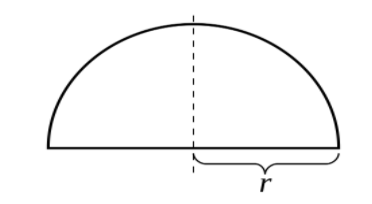
The length of a semicircular tunnel is 2 km and diameter is 7 m. find the expenditure for digging the tunnel at the rate of Rs. 600 per \[{m^3}\]. Find the expenditure for plastering the inner side of the tunnel at the rate of Rs.50 per \[{m^2}\]. (\[\pi = \dfrac{{{\text{22}}}}{{\text{7}}}\])
Answer
577.8k+ views
Hint: Find the volume of the semicircular tunnel and area of the inner side. Then calculate the expenditure by checking the prices given in the problem. In this problem, we have to calculate two answers.
Complete step by step solution:
To start with, we have the length of the semicircular tunnel, \[l\]= 2 km = 2000 m.
The diameter of the semicircular tunnel = 7 m.

Now, radius of tunnel = \[\dfrac{7}{2}\] m = 3.5 m
So, r = 3.5 m, \[l\]= 2000 m,
Volume of semicircular tunnel, which should be half of the volume of the circular tunnel,
= \[\dfrac{1}{2} \times \]volume of circular tunnel
= \[\dfrac{1}{2} \times \]\[{\pi }{{\text{r}}^{\text{2}}}{\text{l}}\]
= \[\dfrac{1}{2} \times \]\[\dfrac{{22}}{7} \times 3.5 \times 3.5 \times 2000\]
= \[11 \times 0.5 \times 3.5 \times 2000\]
= \[38500{m^3}\]
So, expenditure for digging (semicircular) the tunnel at the rate Rs. 600 per \[{m^3}\],
= \[38500 \times 600\]
= Rs. \[2,31,00,000\]
Now, for the expenditure for plastering the inner side of the tunnel at the rate Rs. 50 per \[{m^2}\],
The inner area of the tunnel = \[{\pi rl}\]
So, if we calculate, And inner area of the tunnel = \[{\pi rl}\]= \[\dfrac{{22}}{7} \times 3.5 \times 2000\]= 22000 \[{m^2}\]
So total expenditure = 22000\[ \times \]50
= Rs 11,00,000
Note: We always recommend drawing a diagram first to solve a mensuration problem. There are many variations of this particular question. For example, if we talk about the shape then this shape can be half-square or a rectangle or a cylindrical tunnel. these problems are very common in menstruation. Depending upon shape we’ll use the formulas to solve the question.
Complete step by step solution:
To start with, we have the length of the semicircular tunnel, \[l\]= 2 km = 2000 m.
The diameter of the semicircular tunnel = 7 m.

Now, radius of tunnel = \[\dfrac{7}{2}\] m = 3.5 m
So, r = 3.5 m, \[l\]= 2000 m,
Volume of semicircular tunnel, which should be half of the volume of the circular tunnel,
= \[\dfrac{1}{2} \times \]volume of circular tunnel
= \[\dfrac{1}{2} \times \]\[{\pi }{{\text{r}}^{\text{2}}}{\text{l}}\]
= \[\dfrac{1}{2} \times \]\[\dfrac{{22}}{7} \times 3.5 \times 3.5 \times 2000\]
= \[11 \times 0.5 \times 3.5 \times 2000\]
= \[38500{m^3}\]
So, expenditure for digging (semicircular) the tunnel at the rate Rs. 600 per \[{m^3}\],
= \[38500 \times 600\]
= Rs. \[2,31,00,000\]
Now, for the expenditure for plastering the inner side of the tunnel at the rate Rs. 50 per \[{m^2}\],
The inner area of the tunnel = \[{\pi rl}\]
So, if we calculate, And inner area of the tunnel = \[{\pi rl}\]= \[\dfrac{{22}}{7} \times 3.5 \times 2000\]= 22000 \[{m^2}\]
So total expenditure = 22000\[ \times \]50
= Rs 11,00,000
Note: We always recommend drawing a diagram first to solve a mensuration problem. There are many variations of this particular question. For example, if we talk about the shape then this shape can be half-square or a rectangle or a cylindrical tunnel. these problems are very common in menstruation. Depending upon shape we’ll use the formulas to solve the question.
Recently Updated Pages
Two men on either side of the cliff 90m height observe class 10 maths CBSE

What happens to glucose which enters nephron along class 10 biology CBSE

Cutting of the Chinese melon means A The business and class 10 social science CBSE

Write a dialogue with at least ten utterances between class 10 english CBSE

Show an aquatic food chain using the following organisms class 10 biology CBSE

A circle is inscribed in an equilateral triangle and class 10 maths CBSE

Trending doubts
Why is there a time difference of about 5 hours between class 10 social science CBSE

Write a letter to the principal requesting him to grant class 10 english CBSE

What is the median of the first 10 natural numbers class 10 maths CBSE

The Equation xxx + 2 is Satisfied when x is Equal to Class 10 Maths

Which of the following does not have a fundamental class 10 physics CBSE

State and prove converse of BPT Basic Proportionality class 10 maths CBSE




